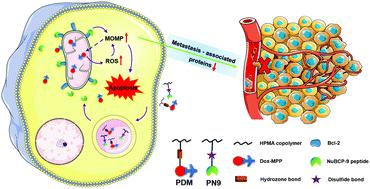当前位置:
X-MOL 学术
›
J. Mater. Chem. B
›
论文详情
Our official English website, www.x-mol.net, welcomes your
feedback! (Note: you will need to create a separate account there.)
Combination of mitochondria targeting doxorubicin with Bcl-2 function-converting peptide NuBCP-9 for synergistic breast cancer metastasis inhibition
Journal of Materials Chemistry B ( IF 6.1 ) Pub Date : 2020-12-24 , DOI: 10.1039/d0tb02564j Jiatao Yang 1, 2, 3, 4, 5 , Qiuyi Li 1, 2, 3, 4, 5 , Rui Zhou 1, 2, 3, 4, 5 , Minglu Zhou 1, 2, 3, 4, 5 , Xi Lin 1, 2, 3, 4, 5 , Yucheng Xiang 1, 2, 3, 4, 5 , Dandan Xie 1, 2, 3, 4, 5 , Yuan Huang 1, 2, 3, 4, 5 , Zhou Zhou 1, 2, 3, 4, 5
Journal of Materials Chemistry B ( IF 6.1 ) Pub Date : 2020-12-24 , DOI: 10.1039/d0tb02564j Jiatao Yang 1, 2, 3, 4, 5 , Qiuyi Li 1, 2, 3, 4, 5 , Rui Zhou 1, 2, 3, 4, 5 , Minglu Zhou 1, 2, 3, 4, 5 , Xi Lin 1, 2, 3, 4, 5 , Yucheng Xiang 1, 2, 3, 4, 5 , Dandan Xie 1, 2, 3, 4, 5 , Yuan Huang 1, 2, 3, 4, 5 , Zhou Zhou 1, 2, 3, 4, 5
Affiliation

|
Distant organ metastasis is the main cause of death in breast cancer patients. Evidences have shown that mitochondria also play a crucial role in tumor metastasis, except for as apoptosis center. However, the treatment of tumor growth and metastasis was reported to be limited by mitochondria-associated protein Bcl-2, which are gatekeepers of apoptosis and are found to reside in mitochondria mainly. Herein, we designed a mitochondria-targeting doxorubicin delivery system as well as a mitochondrial distributed Bcl-2 function-converting peptide NuBCP-9 delivery system, which are both based on N-(2-hydroxypropyl)methacrylamide copolymers, to achieve a synergistic effect on tumor regression and metastasis inhibition by combination therapy. After mitochondria were damaged by mitochondria-targeting peptide-modified doxorubicin, apoptosis was effectively enhanced by mitochondrial specifically distributed NuBCP-9 peptides, which converted Bcl-2 function from anti-apoptotic to pro-apoptotic and paved the way for the development of mitochondrial impairment. The combination treatment exhibited significant damage to mitochondria, including excess reactive oxygen species (ROS), the permeabilization of mitochondrial outer membrane (MOMP), and apoptosis initiation on 4T1 breast cancer cells. Meanwhile, besides enhanced tumor growth suppression, the combination treatment also improved the inhibition of 4T1 breast cancer metastasis both in vitro and in vivo. By increasing the expression of cytochrome C and decreasing the expression of Bcl-2, metal matrix protease-9 (MMP-9) as well as vascular endothelial growth factor (VEGF), the combination treatment successfully decreased 84% lung metastasis. Overall, our work provided a promising strategy for metastatic cancer treatment through mitochondria-targeting anti-cancer drug delivery and combination with mitochondrial distributed Bcl-2 function-converting peptide.
中文翻译:

靶向阿霉素的线粒体与Bcl-2功能转换肽NuBCP-9的组合,可协同抑制乳腺癌转移
远处的器官转移是乳腺癌患者死亡的主要原因。有证据表明,线粒体除了作为凋亡中心外,在肿瘤转移中也起着至关重要的作用。然而,据报道,肿瘤生长和转移的治疗受到线粒体相关蛋白Bcl-2的限制,线粒体相关蛋白Bcl-2是细胞凋亡的守门员,主要位于线粒体中。在这里,我们设计了靶向线粒体的阿霉素递送系统以及线粒体分布的Bcl-2功能转化肽NuBCP-9递送系统,它们均基于N-(2-羟丙基)甲基丙烯酰胺共聚物,可通过联合疗法对肿瘤消退和转移抑制产生协同作用。线粒体靶向肽修饰的阿霉素破坏线粒体后,线粒体特异性分布的NuBCP-9肽可有效增强凋亡,从而将Bcl-2功能从抗凋亡转变为促凋亡,为线粒体损伤的发展铺平了道路。 。联合治疗对线粒体具有明显的损害,包括过量的活性氧(ROS),线粒体外膜的透化作用(MOMP)和4T1乳腺癌细胞的凋亡启动。同时,除增强肿瘤生长抑制作用外,联合治疗还改善了对4T1乳腺癌转移的抑制作用。体外和体内。通过增加细胞色素C的表达并降低Bcl-2,金属基质蛋白酶9(MMP-9)以及血管内皮生长因子(VEGF)的表达,联合治疗成功降低了84%的肺转移。总体而言,我们的工作通过靶向线粒体的抗癌药物递送以及与线粒体分布的Bcl-2功能转换肽的组合,为转移性癌症治疗提供了有希望的策略。
更新日期:2021-01-14
中文翻译:

靶向阿霉素的线粒体与Bcl-2功能转换肽NuBCP-9的组合,可协同抑制乳腺癌转移
远处的器官转移是乳腺癌患者死亡的主要原因。有证据表明,线粒体除了作为凋亡中心外,在肿瘤转移中也起着至关重要的作用。然而,据报道,肿瘤生长和转移的治疗受到线粒体相关蛋白Bcl-2的限制,线粒体相关蛋白Bcl-2是细胞凋亡的守门员,主要位于线粒体中。在这里,我们设计了靶向线粒体的阿霉素递送系统以及线粒体分布的Bcl-2功能转化肽NuBCP-9递送系统,它们均基于N-(2-羟丙基)甲基丙烯酰胺共聚物,可通过联合疗法对肿瘤消退和转移抑制产生协同作用。线粒体靶向肽修饰的阿霉素破坏线粒体后,线粒体特异性分布的NuBCP-9肽可有效增强凋亡,从而将Bcl-2功能从抗凋亡转变为促凋亡,为线粒体损伤的发展铺平了道路。 。联合治疗对线粒体具有明显的损害,包括过量的活性氧(ROS),线粒体外膜的透化作用(MOMP)和4T1乳腺癌细胞的凋亡启动。同时,除增强肿瘤生长抑制作用外,联合治疗还改善了对4T1乳腺癌转移的抑制作用。体外和体内。通过增加细胞色素C的表达并降低Bcl-2,金属基质蛋白酶9(MMP-9)以及血管内皮生长因子(VEGF)的表达,联合治疗成功降低了84%的肺转移。总体而言,我们的工作通过靶向线粒体的抗癌药物递送以及与线粒体分布的Bcl-2功能转换肽的组合,为转移性癌症治疗提供了有希望的策略。











































 京公网安备 11010802027423号
京公网安备 11010802027423号